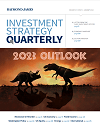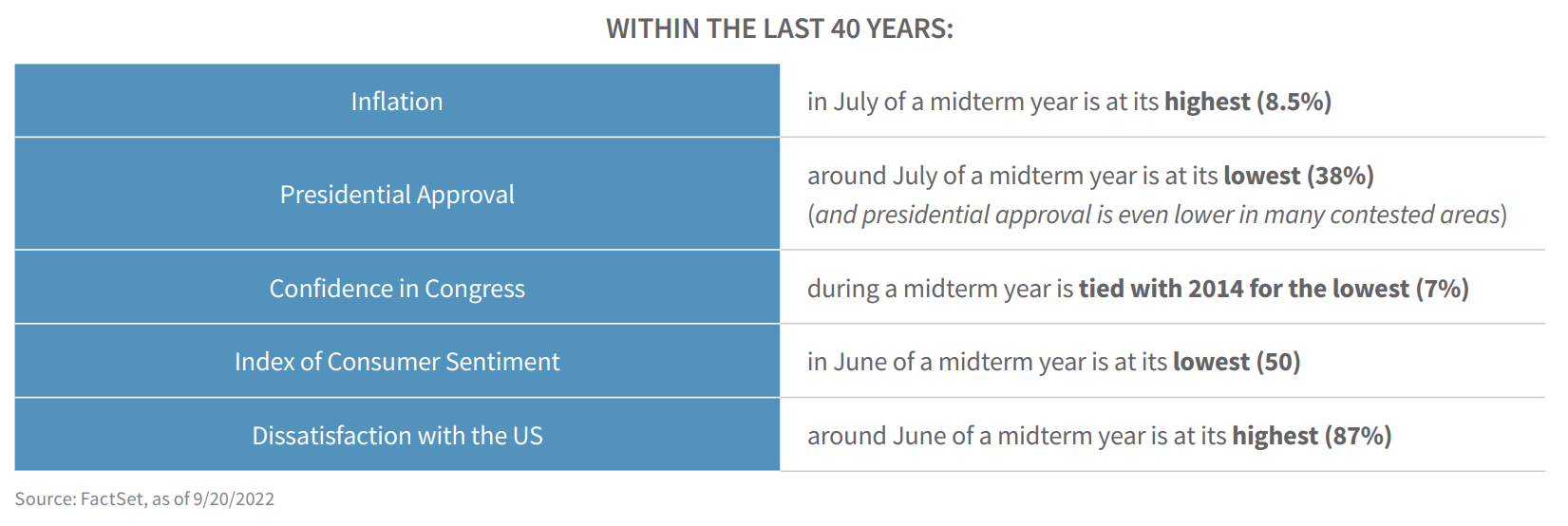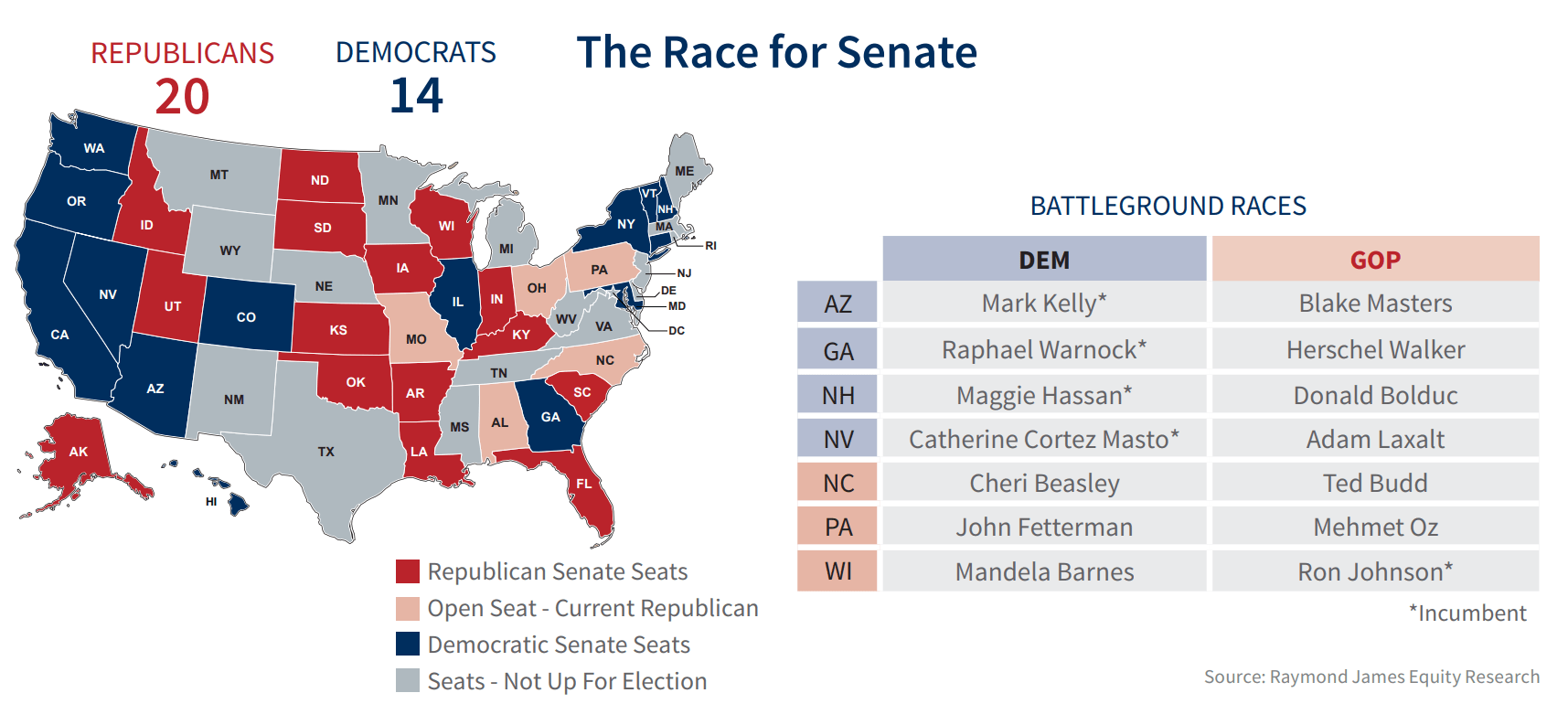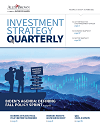A divided government result from the U.S. midterm elections would reduce the risk of significant tax adjustments and outsized budget battles, explains Washington Policy Analyst Ed Mills.
To read the full article, see the Investment Strategy Quarterly publication linked below.
Key takeaways
- In the midterms, Democrats are battling history and an unfavorable macro environment.
- There are signs that the floor is rising in terms of expected Democratic performance that could present resistance.
- Political support for the Biden Administration’s regulatory agenda and the ability of the White House to confirm candidates for top government posts rests with control of the Senate.
- Dobbs decision impacts key Senate races in terms of turnout, enthusiasm, and support from Democratic-leaning independent voters.
- The result of a split Congress following the midterm elections may be the Goldilocks outcome for the markets.
The political set up at the beginning of 2022 carried significant warning signs for Democrats with a political prognosis favoring the election of Republicans. Democrats, now holding the White House and both houses of Congress (five seats in the House and tied in the Senate), are not only battling history (the party controlling the White House has lost an average of 23 seats in the midterms over the last 40 years), but they are also battling a macro environment that traditionally is a political albatross for the party in power.
Polling shows near record levels of dissatisfaction with the direction of the country among voters, historically low approval ratings for President Biden, and inflation concerns are dominating headlines. Looking at the data, voters’ minds regarding midterm elections have traditionally been effectively made up around the spring of a midterm election year. In fact, presidential approval has not been shown to materially improve in the past 40 years from the spring into the fall of a midterm election.
However, while there are still significant structural factors that favor Republican candidates in this midterm cycle, we are seeing signals that the floor is rising in terms of expected Democratic performance that could present unexpected resistance for Republicans’ chances of significantly altering control of Washington.
Recent electoral surprises favoring Democrats in Kansas, New York, and Alaska highlight that the race is more fluid than many had expected at the start of this year. The traditional voter enthusiasm behind challengers is in part being matched by voters responding to the recent Supreme Court decision in Dobbs v. Jackson Women’s Health Organization. Additional factors motivating Democratic voters and Democratic-leaning independents include a string of high-profile legislative victories, including domestic technology manufacturing incentives and a finalized reconciliation bill that directs new funding toward clean energy production and extends healthcare coverage for many Americans. Further, the announcement of action on student debt relief will also be weighed as a motivating factor for younger voters.
In all, while we continue to expect that Democrats are likely to lose the House (and with it, their Congressional majority), prospects for Democrats retaining the Senate have materially improved into the fall. This will have important market impact in terms of the Biden administration’s regulatory agenda and confirmation ability for key posts if Democrats ultimately maintain or expand their Senate majority.
Favorable environment for Republicans, but don’t discount Democrats
The overall trend in national political factors has been one of a Democratic recovery relative to the national environment seen earlier this year. The increased prominence of social issues, sustained labor market recovery, and the potential peak of inflation (if the downward trend in domestic energy prices holds) alleviate some of the pressure that has capped Democrats’ prospects.
While we continue to see material Republican gains (most likely in the House), the likelihood is growing that the earlier forecasted “Red Wave” is dampened by a reinforced “Blue Wall,” particularly when it comes to improved chances for Democrats to hold the Senate. In effect, the result of a split Congress following the midterm elections may be the Goldilocks outcome for markets. With this setup, any further threat of significant tax adjustments will be off the table until 2025. Headline risk on budget/debt ceiling battles will also be less of a factor, as these fights are likely to stay within Congress and be resolved, rather than pit a unified Republican Congress against a Democratic White House.
While we view a scenario of Democrats controlling both the House and Senate in 2023 as the possibility with the lowest odds, this would also be the scenario that would drive an outsized market reaction. Legislative risk driven by tax increases as part of the Democratic reconciliation and social policy agenda is now largely viewed as a nonfactor by the market given the current political setup but would be poised for a resurgence on the off chance that Democrats overperform and maintain control of both chambers of Congress.
We caution that the electoral landscape will continue to be fluid up until the election, and that recent cycles have shown that “unprecedented” results cannot be fully discounted.

Read the full
Investment Strategy Quarterly
Read the full
Investment Strategy Quarterly
* Transfer receipts are benefits received by persons for which no current services are performed. They are payments by government and business to individuals and non-profit institutions.
All expressions of opinion reflect the judgment of the author, the Investment Strategy Committee, or the Chief Investment Office and are subject to change. Past performance may not be indicative of future results. There is no assurance any of the trends mentioned will continue or forecasts will occur.
Markets & Investing Members of the Raymond James Investment Strategy Committee share their views on...
Markets & Investing Review the latest Weekly Headings by CIO Larry Adam. Key Takeaways ...
Technology & Innovation Learn about a few simple things you can do to protect your personal information...


